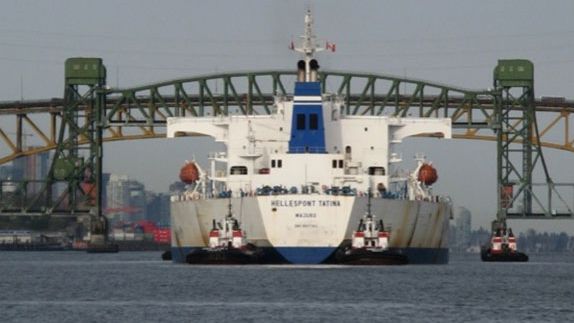Engineers Call for B.C. Tanker Risk Assessment

A group of engineers is petitioning for a full risk assessment of tanker traffic through Vancouver's Second Narrows, traffic that would increase to a ship a day if Kinder Morgan's Transmountain pipeline expansion is appoved.
The Second Narrows has two bridges – a low railroad drawbridge and a highway. The engineers are concerned that a rudder failure could send a loaded Aframax drifting into a rail bridge span, then carry that span's tower into the highway bridge 400 feet to the west.
While this worst-case scenario sounds unusual, they note that it is not unprecedented: in 1979, the 25,000 dwt freighter Japan Erica struck the rail bridge at low speed, knocking the north tower span off its footing and pulling the north lift tower off at an angle.
The Aframax tankers lifting crude from Transmountain’s Westridge terminal are about four times larger than the Erica.
Under current regulations, these tankers can only transit the Second Narrows in daylight and at high tide. They carry two B.C. pilots each and are escorted by tugs. The engineers acknowledge the value of these risk mitigation measures, but they expressed concern that the government has not conducted a formal project risk assessment covering the tanker transits.
Given "a sevenfold increase in tankers through the Second Narrows bridges, I'm amazed the federal government has not done a proper risk assessment about traffic through these two bridges," said engineer Brian Gunn, who retired as engineering manager for North America's busiest coal terminal, Westshore Terminals.
In addition to petitioning for a risk assessment, the engineers noted that Kinder Morgan estimates a 10 percent chance of a spill over the 50-year lifetime of the project, and suggested that this level of risk is unusually high relative to the acceptable level for buildings, highway bridges and other infrastructure projects.
Transmountain said in a statement last year that there have been no groundings, collisions or contacts during a tug-escorted transit of the Second Narrows since 1980.
Further, “for about 60 years, tankers have traveled through the [Second Narrows] without incident,” says Peter Xotta, VP of operations and planning for Port of Vancouver. “In that time, safety standards have continued to become more stringent.”
